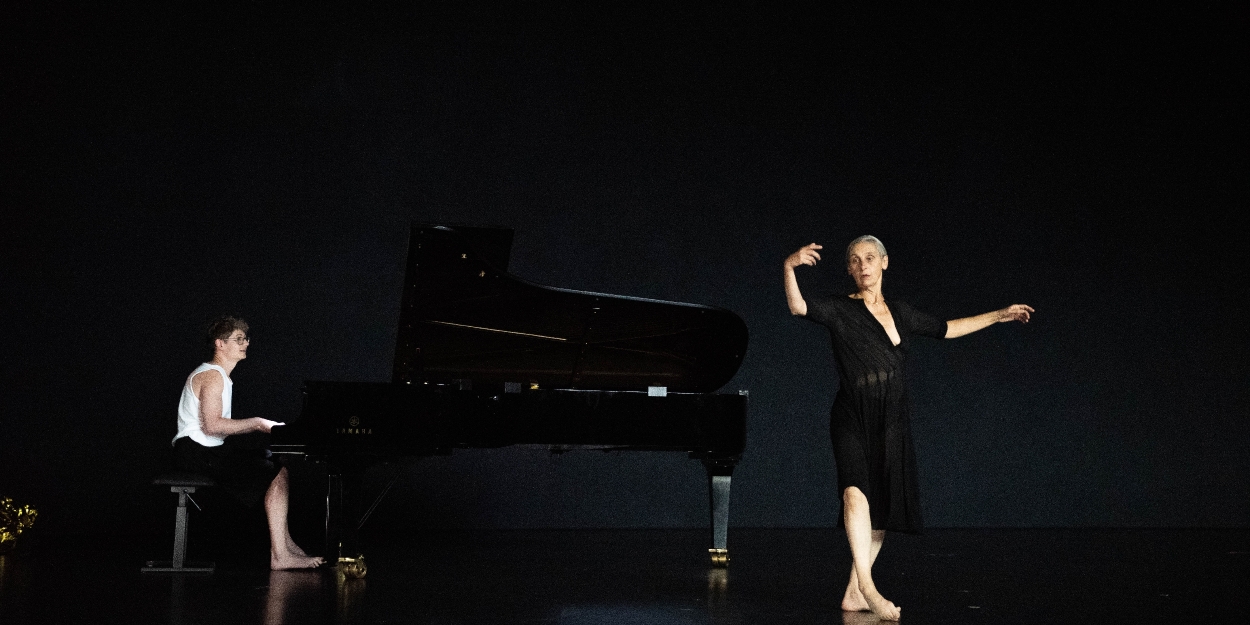Review: THE GOLDBERG VARIATIONS, BWV998, Sadler's Wells
Seminal choreographer and Beyoncé inspiration Anne Teresa De Keersmaeker is Bach, sorry, back.

![]() Complex chords are paired with seminal choreography in The Goldberg Variations, BWV 988 from dancer Anne Teresa de Keersmaeker and pianist Pavel Kolesnikov.
Complex chords are paired with seminal choreography in The Goldberg Variations, BWV 988 from dancer Anne Teresa de Keersmaeker and pianist Pavel Kolesnikov.
De Keersmaeker has been creating dance pieces for over forty years through her company Rosas and fans include Beyoncé who paid tribute to her choreography in the music video for "Countdown". The Belgian artist is heavy influenced by music from classical and contemporary composers but her last outing based on the work of Johann Sebastian Bach was a very different production.
While The Six Brandenburg Concertos had a large cast, Goldberg is more of a stripped down affair. Here, De Keersmaeker and Kolesnikov are the sole artists on the huge Sadler's Wells stage with very little other than a grand piano filling the physical space. The Variations were apocryphally created for an insomniac but it can hardly be called somnolent. It is considered by some the most serious and ambitious work for keyboard and Kolesnikov shows serious skill in flawlessly playing this long, complex and technically demanding Baroque piece which requires awkward hand crossing at times when played on a piano (Bach intended the Variations to be played on two manuals on a harpsichord).
De Keersmaeker has incorporated many of her physical trademarks, not least the way she swings her arms, her geometrical movements across the floor and the use of walking alongside the more usual dance techniques. The twists, bends and hair flips from her seminal 1983 work Rosas danst Rosas are all present and correct. Whether twisting vertically through a quarter, half or full turn, she is precise and poised throughout and her quietly controlled manner is a powerful counterpoint to Kolesnikov's often frenetic hand motions as he charges through variation after variation.
Clothing is used in Goldberg to set the mood and add drama. Both start out barefoot in light clothing, the dancer braless in a long black see-through dress and the pianist in a white T-shirt and black knee-length shorts. After the "technical break" - book-ended by De Keersmaeker rolling a long metal pole from the rear of the stage to the front and then back again - the pair emerge in more formal wear (a white dress shirt, black trousers and shoes for Kolesnikov and a Seventies-style tan leisure suit and blouse for De Keersmaeker). Soon after, she strips down to silver hot pants and, at one point, with her back to the audience, pulls down her blouse down to her waist before pausing for a few beats.
As well as her moves, the dancer brings back some signature theatricality, not least the concept of time shifting through nocturnal phases. The dull glow reflecting off a large silver panel to one side simulates moonlight and, after a short period of complete darkness, a pile of what appears to be tinfoil is brightly lit to presumably indicate the start of a new day. This effectively evokes the crepuscular moods of dusk and sunrise previously seen in seminal early pieces like Fase and Rosas danst Rosas.
These theatrical aspects add welcome splashes of colour and substance to a two-hour show which at points drags. With no kind of interval outside the short break (in which we are asked to stay seated), De Keersmaeker's rehashing of her abstract and repetitive motions and staging motifs from previous creations feels a tad indulgent by the end, especially as they do not build in Goldberg to a satisfactory climax. The shape is there but this is a baggy work that, despite some excellent playing from Kolesnikov, doesn't ultimately coalesce into a cohesive and coherent whole. Indeed, a pinch of the staging's minimalist ethos would work wonders were it applied to the choreography.
The Goldberg Variations, BWV 988 by Teresa De Keersmaeker and Pavel Kolesnikov completes its two-night run at Sadler's Wells tonight (7 September).
Photo credit: Anne Van Aerschot
Reader Reviews

Videos

